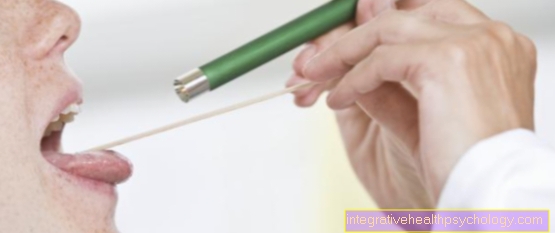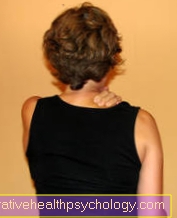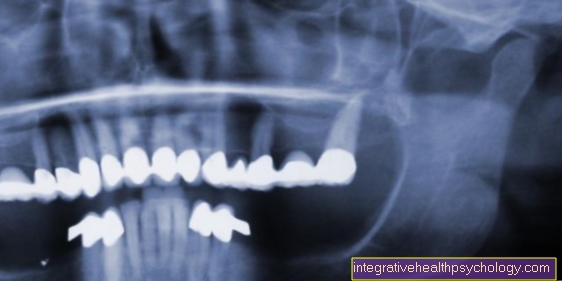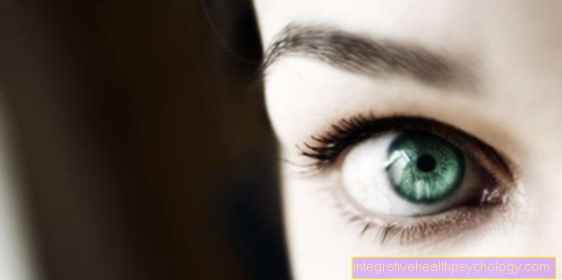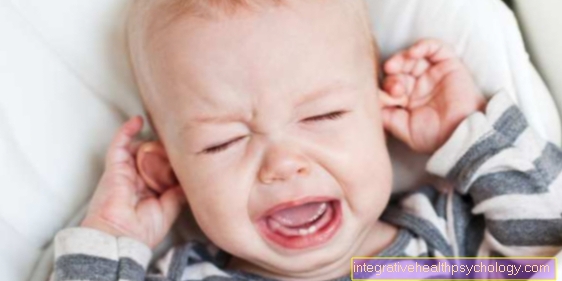Presbyopia
definition
With age, the elasticity of the lens decreases, which also reduces your refractive power.
This mechanism, which is physiological in old age, results in presbyopia (in technical terms also Presbyopia called).
It is characterized by the fact that it is difficult to see close up. Reading small letters is particularly difficult.
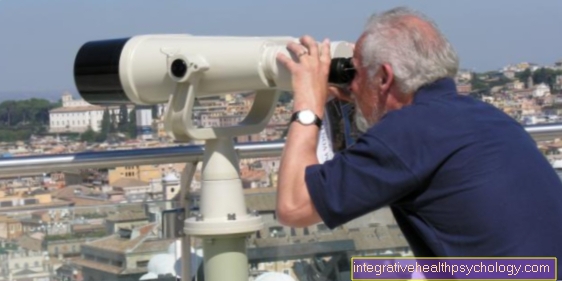
introduction
Presbyopia is a normal process that affects everyone as they age. It starts around the age of 40. The term presbyopia is actually wrong, as there is no farsightedness in the original sense. With farsightedness, namely, the eye is too short. The increasing weak eyesight in old age has other causes.
The lens becomes less elastic over time and is less able to roll off. Thus, the refractive power decreases and things that are close to the eye can no longer be seen clearly. The only remedy is reading glasses.
Presbyopia is a slowly progressing process that is completely physiological, i.e. normal, and is part of getting older.
Cause of presbyopia
The eye is composed of many individual components.
For sharp vision and its pathomechanism (Mechanism that brings about a disease and by which the development of the disease can be explained) the interaction between lens and cornea is primarily responsible.
The lens is part of the visual system of the eye. It is biconvex (arched outwards on both sides) and consists mainly of proteins and water. By changing its curvature, the refractive power can be changed so that objects near or far can be seen clearly.
This mechanism is known as accommodation.To see sharply up close (for example when reading) the lens loops. This balling with increasing curvature is based on the inherent elasticity of the lens.
In order to see in the distance, the lens is stretched in length and width by fibers attached to it, i.e. flattened. The lens is nourished and supplied by the aqueous humor surrounding it, which is located in the eye around the lens. The lens has no blood vessels and is completely colorless and transparent.
In the case of presbyopia or farsightedness, this balling process is now hindered or restricted. The more elastic the lens, the greater the increase in lens curvature. This elasticity is lost with age and thus leads to so-called presbyopia.
The rigid core of the lens becomes larger, which takes place at the expense of the soft cortex. So the ability to accommodate continues to decline. This process begins at birth, but progresses slowly. The presbyopia only becomes noticeable above a certain narrow range of the ability to accommodate. This process can be identified from around 40 to 50 years of age. People with farsightedness at a younger age notice this process earlier.
When does presbyopia begin?
The refractive power of the eye decreases continuously in the course of life. Presbyopia is the poor eyesight that results from the reduction in the elasticity of the lens.
From the age of 40, the reduction in elasticity manifests itself as poor eyesight: the patient can suddenly no longer see objects clearly near them. From this age onwards, the poor eyesight also increases rapidly. Up to the age of 55 it increases faster and faster, after that less quickly.
Here, too, one must bear in mind that the values are variable for each individual person and that the symptoms of presbyopia do not appear in everyone at the same age.
Symptoms
Presbyopia manifests itself primarily in the fact that the affected patients have more and more difficulties reading.
With the onset of presbyopia (presbyopia) reading is perceived as exhausting. The text to be read must be kept further and further away from the eye in order to be seen clearly. When reading for a long time, a dull feeling of pressure can develop in the forehead or eyes area, and sometimes lead to headaches.
Read more on the topic: Eye pain.
Diagnosis of presbyopia
Presbyopia is diagnosed (Presbyopia) mostly about the complaints expressed by the patient when reading. If the eye doctor then checks the eyesight, defects in near vision are found.
What tests are used to diagnose presbyopia?
Presbyopia can be determined by an optician using normal eye tests. The optician first lets the patient read something from a newspaper or book as normal. The posture that a patient with presbyopia adopts provides some important clues about the disease: he stretches his arms as far away from the body as possible, while at the same time pushing his head back. This increases the distance between the eye and the reading.
After this orientational assessment, the optician determines the eyesight using eye charts and glasses of different strengths. It works in the same way as a normal eye test at an optician's: The patient is put on test glasses and is supposed to read letters from a certain distance. As soon as he can no longer read something, the optician changes the glasses until reading is again possible without any problems. In this way, it determines the patient's diopter, i.e. the individual refractive power of the eyes. The diopter value also provides information about the strength of the lenses in order to be optimally adapted to the patient.
How many diopters does the refractive power of the eyes deteriorate in presbyopia?
How many dioptres the refractive power changes in presbyopia cannot be said in general terms. Rather, it is an individual value that is different for each patient. Presbyopia becomes symptomatic at the age of 40.
In the beginning, an additional diopter is usually sufficient to increase the refractive power. In the course of time, however, the elasticity of the lens decreases more and more quickly. From the age of 40, the elasticity of the lens decreases exponentially. This means that at the age of 50 the patient still needs 2 additional dioptres of refractive power in order to see clearly in the vicinity.
However, these values must be determined individually by the ophthalmologist or optician, as they can deviate considerably from these guide values.
Therapy of presbyopia
Presbyopia can only be treated with reading glasses. The glasses of the reading glasses are so-called converging lenses. So they are curved outwards on at least one side, sometimes on both sides (convex).
Outwardly curved lenses concentrate the incoming light rays. Thus, they help the patient with presbyopia to compensate for the inability of the lens to roll off. These glasses bundle the rays before they hit the lens of the eye. They also help the “decrepit” lens to see close up sharply.
Find out more about the topic here Glasses.
Laser therapy for farsightedness
Not so long ago, a laser treatment for presbyopia, as has been possible for some time with other disorders of accommodation, was not crowned with success Presbyopia a decrease in elasticity of the lens is the cause of the decreasing ability of the eye to focus.
But now, in Germany too, patients with presbyopia are being treated using laser procedures. In most cases, these are still studies in which experience is to be gathered and long-term results are to be made available, so that the current state of knowledge at the national level does not yet allow any statement to be made about the long-term success of laser surgery in presbyopia.
Read more on the topic: Have presbyopia lasered.
Contact lenses for presbyopia
As a rule, the therapy of choice for presbyopia (Presbyopia) first of all reading glasses. It is a pair of glasses with converging lenses that compensate for the lack of accommodation capacity of the eye lens due to a loss of elasticity as well as possible.
But contact lenses are also a way to remedy visual impairment.
Both patients who were previously normally sighted and those who were previously farsighted or also nearsighted can counter presbyopia with contact lenses.
The required diopter values must be specially calculated in each case.
Otherwise, the same applies to wearing contact lenses in presbyopia as in all other accommodation disorders: It is important to find the right lens and to maintain hygienic handling so that wearing it remains comfortable and the eyes are not damaged.
If the presbyopia still progresses, the contact lenses have to be readjusted every now and then, if the person concerned notices that he is having difficulty seeing up close again.
However, this does not happen quickly, but usually rather slowly, so that a readjustment all (pair) Years is often sufficient.
As for the choice between hard and soft contact lenses, it is up to the person concerned.
Both types of contact lenses can help with normal presbyopia, so it is a personal decision which contact lens suits you better and is more comfortable to wear.
What should you watch out for with contact lenses and presbyopia?
Anyone who suffers from presbyopia but does not want to wear glasses can have contact lenses made by the optician. These contact lenses differ from conventional contact lenses in that they must enable the reader to see clearly both in the distance and up close. So you have to meet the same conditions as a progressive lens.
The most commonly used models are so-called monovision lenses. With this lens system, one eye is corrected into the distance and the other nearer. That sounds irritating at first, but the brain is only able to adjust to close-ups or television.
Other types of lenses are built according to the progressive lens system: the upper part of the lens is designed for near vision, the lower part for far vision. It is important with this lens system that the lenses can slide easily on the eye and that their position does not change. You also have to get used to using these lenses first.
It is best to discuss which lenses are best for you with your eye doctor or optician.
What is a lens implant?
A lens implant is an artificial lens that can be inserted into the patient's eye in the event of lens opacification or gross ametropia (caused by the lens). There is also the option of removing the old lens. This is the case with lens opacification. If you have poor eyesight, you can leave the old lens in the eye. Then the new one is also used.
In the case of presbyopia, multifocal lenses are recommended. These lenses have two focal lengths: one for near vision and the other for far vision. They enable the patient to read without reading glasses.
There are also so-called accommodating intraocular lenses. These imitate the refraction of the lens of the eye, and thus also replace reading glasses.
rehabilitation
Rehabilitation is unfortunately not possible, as the lost elasticity of the lens cannot be regained. A certain amount of reading glasses can help.
Which eye training helps against farsightedness?
It is questionable whether regular eye training can really prevent presbyopia or reduce its symptoms. Presbyopia is caused by a stiffening of the eye lens, which occurs naturally in old age. You can't really do anything about this stiffening. Eye exercises may help insofar as the movement promotes blood flow to the entire eye and thus also to the lens. As a result, the lens is better supplied with nutrients and remains more elastic. However, the benefits of eye training have not been scientifically proven. You have to decide for yourself individually whether eye training really helps.
Below are some specific eye exercises.
- Close your eyes and let your eyeballs circle in all directions.
- Extend your arm forward and bring it back towards your body. Fix your thumb with your eyes. This exercise trains the eyes to react and adapt quickly to different distances.
- Change your gaze frequently between near and distant objects.
prophylaxis
Nothing can be done preventively with this disease. This process is age related and cannot be stopped.
The loss of elasticity cannot be counteracted to this day. The lens loses its ability to loosen up a little more every day from birth. Fortunately, this continuous progress is only noticeable late. In a patient with normal vision, the decreasing elasticity only affects everyday life from the age of 45.
However, you can get used to some behavior to keep your eyes fit in everyday life.
-
Healthy nutrition - it promotes regenerative processes in the eye.
-
Regular eye training - keeps the eye muscles fit.
-
Watch TV or work on the computer in moderation (if possible). The artificial light from electrical devices has been proven to be harmful to the eye. In addition, the constant stare at a screen from the same distance rusts the eye muscles.
Is there a connection between presbyopia and diet?
It is controversial whether there is actually a connection between diet and the extent of presbyopia. There are sources claiming that certain vitamins and trace elements, taken in sufficient quantities, can reduce or delay presbyopia. However, this theory has not been scientifically proven. Nevertheless, a balanced diet promotes health and has a positive effect on regenerative processes in muscles, tendons and, last but not least, in the brain, which enables visual perception at all.
What role do vitamins play in presbyopia?
Since the development of presbyopia is a natural process, it can only be stopped to a limited extent, but never completely. There are certain vitamins that are responsible for the regeneration of certain antioxidants in the lens. These antioxidants are responsible for removing radicals in the eye that would otherwise damage the lens tissue.
The vitamins responsible for this are called lutein and zeaxanthin. They are mainly found in carrots, spinach, cabbage, Swiss chard and other leafy vegetables.
homeopathy
The effect of homeopathic remedies on presbyopia has not been scientifically proven. For this reason, we cannot recommend any specific homeopathic remedies. If you believe in homeopathy, you can discuss the subject with your alternative practitioner.
forecast
Presbyopia (Presbyopia) is a slowly progressing and actually normal aging process of the eyes which is based on a loss of elasticity Eye lens is based.
In this respect, it can be said about the prognosis of presbyopia that as a rule no regression or improvement pre-existing symptoms occur unless they go beyond the normal extent of the aging process.
In general, however, the inability to accommodate to close proximity does not increase indefinitely but comes to a halt sooner or later.
Most older people live with farsightedness around +1 to +3 diopters.
In a person with previously healthy eyesight, presbyopia begins at around 45 yearsto slowly become noticeable. For example, the newspaper or book must be held further away so that it can be read clearly.
After a certain age, practically everyone needs one Reading glasses or one other correctionthat helps with the close-up focus that the eye can no longer manage on its own.







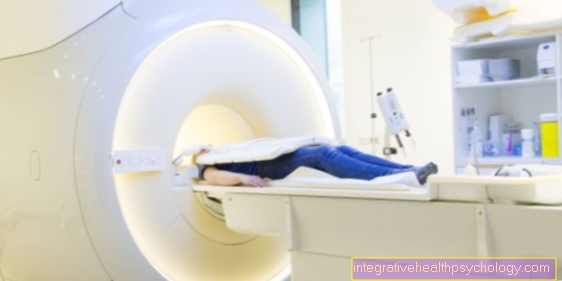
.jpg)
